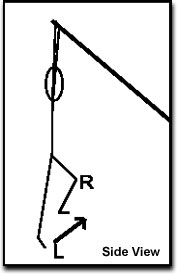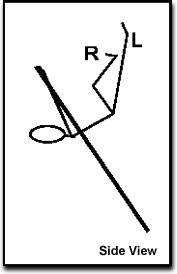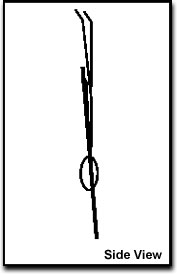Narrow Grip Drill
|
Article
By: Brian Yokoyama,
Mt.
San Antonio College (Mt. SAC)
|
A
Better Drill For A New Generation Of Pole Vaulters.
For many
years, Americans have used the rockback drill (swinging to the
upside down perpendicular position by straight poling) to help
develop the swing. When comparing the current pole vaulting technique
used by the Europeans, Japanese and Russians, it is apparent that
this particular drill has outlasted it's usefulness.
DRILLS
ARE USED TO HELP DEVELOP DESIRED MOTOR PATTERNS IN AN ACTION
In developing motor patterns there are two major principles
when using drills:
1. The
closer a drill emulates the desired motor action, the better the
transfer rate.
Example = The closer a drill emulates the actual vault,
the more effective the drill.
2. A drill
which is repeated over and over, will eventually form a motor
pattern.
Example = A technique (good or bad) which is constantly
repeated in a vaulting drill will be transferred to the actual
vault.
The rockback
drill which is currently being used by most vaulters in the US
develops few beneficial techniques, while fostering many harmful
ones. The narrow grip drill is a better drill, which develops
the benefits of the rockback drill without its harm.
The
narrow grip drill is essentially the same as the rockback drill
except that the hands are placed as close together as possible.
|
ROCKBACK
DRILL
|
|
Benefits
|
Harmful
Effects
|
|
• Develops a
long swing
• Develops turning in front of the bar
|
• Teaches
to collapse arms in order to swing
• Allows vaulter to swing, even when under at takeoff
• Allows vaulter to "muscle" the pole drop
• Allows vaulter to set up the plant late
• Allows vaulter to carry the pole behind the hip |
|
NARROW
GRIP DRILL
|
|
Benefits
|
Harmful
Effects
|
• Develops
a long swing
|
• |
•
Develops turning in front of the bar
|
• |
•
Develops keeping arms extended throughout the swing
* Allows
energy loaded in the pole to be conserved |
• |
• Develops
a proper takeoff
* Free takeoff/unobstructed takeoff
* Body must be tall & fully
extended
* All energy is focused upward
into the pole
* Does not allow the vaulter
to swing when under the plant |
• |
• Develops
an early and proper set up
* Arms initiating the plant
* Arms continually driving upward |
• |
• Develops
a proper pole carry
*
Vaulter must
use proper pole carry mechanics/timing |
• |
THE
NARROW GRIP DRILL FORCES PROPER TECHNIQUE AND DEVELOPS CORRECT
MOTOR PATTERNS

Highbar
Phase
Figure 5 |

Swing
Phase
Figure 6 |

Vertical
Phase
Figure 7 |
A.
Both arms are extended directly overhead and rowing forward.
B. Both arms are placing
equal pressure upward into the pole.
C. Trail leg is extended
and swinging upward.
D. Right leg is in a well
balanced position (flamingo position). |
A.
Both arms are extended and rowing forward, keeping energy
in the pole.
B. Trail leg is straight
(transferring horizontal energy into vertical energy).
C. Rotation of the body
occurs mostly at the shoulders. |
A.
Vaulter is in a rigid extended position.
B. Both arms are extended
(keeping energy in the pole).
C. Right arm is actively
rowing toward the right hip and continuing on through.
D. Lead leg extends. |
10
Keys to Success
1. Maintain a high center of mass.
2. Takeoff should be smooth (no shock).
3. Balance, balance, balance (be balanced).
4. The higher the grip (with fast pole speed) the better.
5. On the left support phase (fig. 1), drive body upward
to allow time/space to get the right support foot and takeoff
foot get directly under center of gravity for maximum power (penultimate).
6. Beginner drill progression:
A. Swing into the sand pit (no swinging to vertical
phase).
B. Swing to vertical.
C. Spread hand grip and vault (bending pole).
7. Keep hands close together (touching).
8. Keep arms fully extended from takeoff on.
9. All energy must be driving upward at takeoff (arms,
body, legs).
10. Mastery of this drill occurs when the vaulter can take
a full vault, bending a pole above his/her body weight (on a pole
2 feet shorter than his/her biggest pole) from 3 lefts or 3 rights.
![]()



